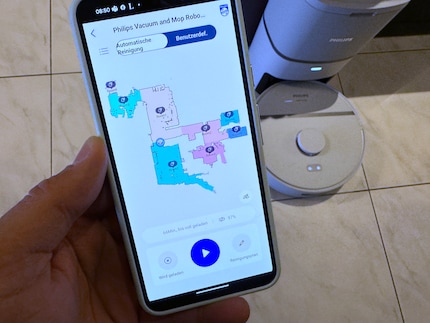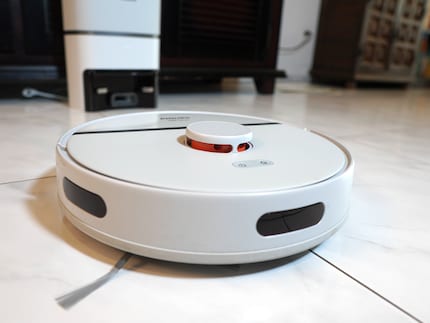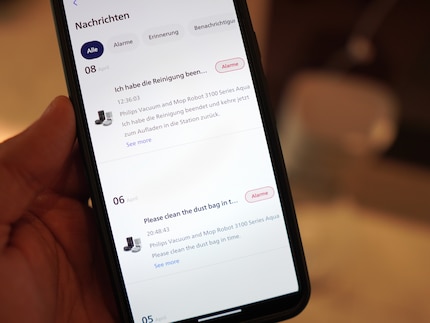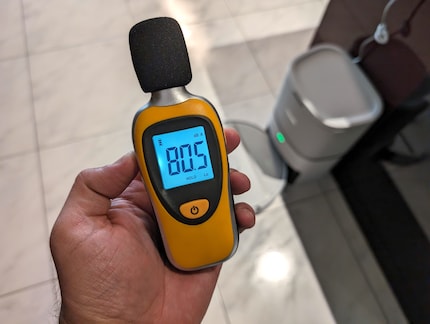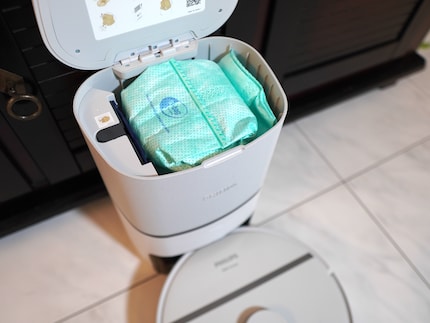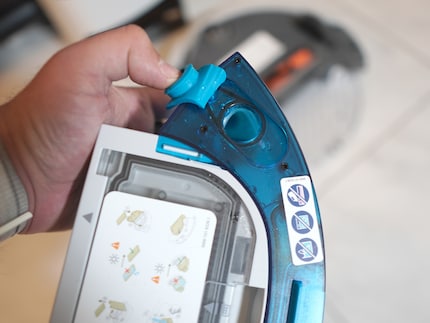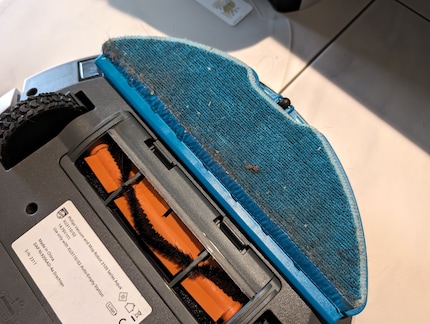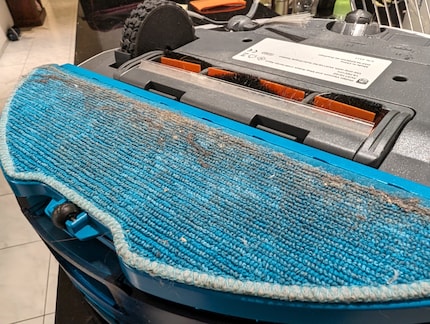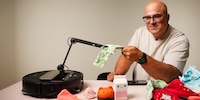
Product test
Roborock Saros Z70: how good is the first ever robot vacuum with a mechanical arm?
by Lorenz Keller

The robot hoover from Philips aroused my emotions when tested. Positive ones, for example, with its precise navigation from room to room. But also negative ones with annoying dropouts in the app, for example.
The test begins with a highlight. The Philips 3000 scanned the 120 square metre family home in just six minutes. This makes the robot for 600 francs or euros just as good as the fastest top models, which cost twice as much.
The map created is precise. Even the room layout is more or less correct, I just have to separate the two bedrooms and assign part of the hallway to the living room - and the robot hoover is ready to go. Unfortunately, not everything goes as smoothly as the start during testing. Pleasure and frustration alternate.
What stands out positively during installation: I can use the Philips 3000 app without having to create a login for it. The floor plan of the flat is therefore not saved in the cloud, but only locally on my robot. The device doesn't record images or videos anyway. Many competitor models automatically save plans and even recordings of the home in the cloud, which not all users like.
The Philips 3000 can create such an accurate map because it uses a lidar scanner: a type of radar with laser light. This means that the robot vacuum not only measures the rooms quickly and accurately, but also finds its way around the home with ease.
The Philips is as good as the top devices from Dreame or Ecovacs. It easily finds every room I send it to clean. Even the return journey to the base station is no problem. The manufacturer has done a really good job here.
Like many other vacuums with lidar navigation, however, the Philips has a small problem in my flat: the scanner "sees" through the glass doors onto the balcony and has the feeling that the room here goes even further. However, this has no negative impact on everyday cleaning, as the robot quickly realises that it can't clean there.
Luckily, I can set up a restricted zone. Unfortunately, as with the competition, I can't delete the incorrectly scanned area. The partially scanned balcony remains on the map. However, this is a purely visual problem.
Not everything runs smoothly during installation. Right from the start, the Philips 3000 failed to install an update to the robot software. However, dazzled by the great Lidar scan, I put this to one side. And after several more attempts with error messages, the update was finally installed.
But that was just the beginning: the app and software kept annoying me throughout the entire test. After half a dozen cleanings, for example, the map suddenly disappeared from the app. Goodbye and goodbye ever again. So I have to tidy all the rooms again and scan the flat from scratch a second time.
Luckily, it's quite quick, but it's still annoying. I decide to set up an account with Philips. That way, the plan of my flat is at least saved in the cloud. A wise decision, as the map suddenly disappears a second time a week later, but is then quickly reloaded via the cloud.
What's also strange is that the app reloads the map every time anyway. This always takes two to three seconds, sometimes even longer. So I'm always worried that I've lost all my data.
The app also looks unfinished in other respects. Texts are cut off and not everything is translated from English to German.
An important function can also only be called up with far too much effort, namely the quick cleaning of individual rooms. I always have the choice between automatic and customised cleaning. In the first case, everything is vacuumed and moped. In the second case, I can decide for myself which rooms are cleaned, with which technology and how often. I can also set the suction power and the amount of water.
Programming user-defined cleaning takes a few too many clicks. What's more, the cleaning schedule is saved permanently each time and cannot be edited. I have to delete it each time before I can create another variant. As I often only have individual rooms vacuumed, I particularly noticed this. With the competition, I can clean rooms much more quickly, easily and specifically.
Philips specifies the suction power at 4000 pascals - a mediocre value. For comparison: the top models reach 8000 and more Pascal. However, there is no standardised measurement, so direct comparisons are difficult.
What I can say from the everyday test: The Philips 3000 vacuums thoroughly and comprehensively. In regular use, I don't notice any major difference to the top models. The rubber roller with bristles, combined with the sufficient suction power, does a good job.
Cleanliness in corners and edges is not quite as high because there are no extendable mops or other special tools as in the top models. Instead, a classic side brush rotates some of the dirt in front of the robot so that it can be vacuumed up there.
Overall, however, I am satisfied with the cleaning of dust and dirt. It is also pleasing that the robot is not particularly loud in normal suction mode at 65.9 decibels. Unlike the suction station, which makes a lot of noise at 80.5 decibels, like many other hoovers.
In the base station, which is only 40 centimetres high and 26 centimetres wide, the dust is vacuumed into a bag with a capacity of three litres. According to Philips, the hoover is suitable for allergy sufferers. In fact, an Epa11 filter is installed, which absorbs 95 per cent of all airborne particles. A 99.95 per cent Hepa filter is usually recommended for people with allergies. However, such a filter is only installed in a few robot hoovers.
By the way, the battery lasted well enough for my 4.5-room flat with 120 square metres, so the Philips can keep up with the best. And thanks to its height of less than 10 centimetres, the robot also fitted easily under my sofa and bed.
The Philips 3000 can not only vacuum, but also mop. To do this, it has a crescent-shaped mop that is pulled across the floor. The good news first: Philips also includes a replacement textile cover.
I also need this as the base station cannot clean the mop. I have to do it by hand. Refilling the water is not automatic either. I have to pull the tank out of the robot and fill it up manually at the tap.
This would all be fine if the mop was reasonably effective. But that's not the case - as the cleaning technique is very simple. The mop is moistened by the water tank and pulled across the floor - just like I would do by hand.
This works reasonably well if I clean the flat room by room and then change and wash the mop each time. But a lot of efficiency is lost. If I leave the mop on to clean several rooms, it's totally dirty afterwards and leaves wet dust streaks on the floor.
What is also annoying: If the Philips 3000 gets caught somewhere, which it almost always does with cables, for example, it spins around like crazy and constantly wets the mop - so that the floor there is wet.
By the way, if I just want to vacuum, I have to take the mop off, even if the manufacturer doesn't say so anywhere. Otherwise, the textile part is simply pulled dry across the floor, collects dust and, in the worst case, spreads it somewhere again.
The Philips 3000 is a good robot vacuum cleaner that navigates excellently and quickly. The manufacturer should have limited itself to these functions - and lowered the price a little in return. Instead, it has given the mid-range model a mop that I wouldn't use in everyday life. Or really only very specifically, for the bathroom for example.
The confusing app, which has repeated bugs and, with its lack of translations and complicated operation, also appears unfinished, was also unconvincing when tested. At least Philips could still correct this with updates.
Pro
Contra
Gadgets are my passion - whether you need them for the home office, for the household, for sport and pleasure or for the smart home. Or, of course, for the big hobby next to the family, namely fishing.

Product test
by Lorenz Keller
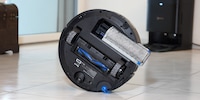
Product test
by Lorenz Keller

Product test
by Lorenz Keller
